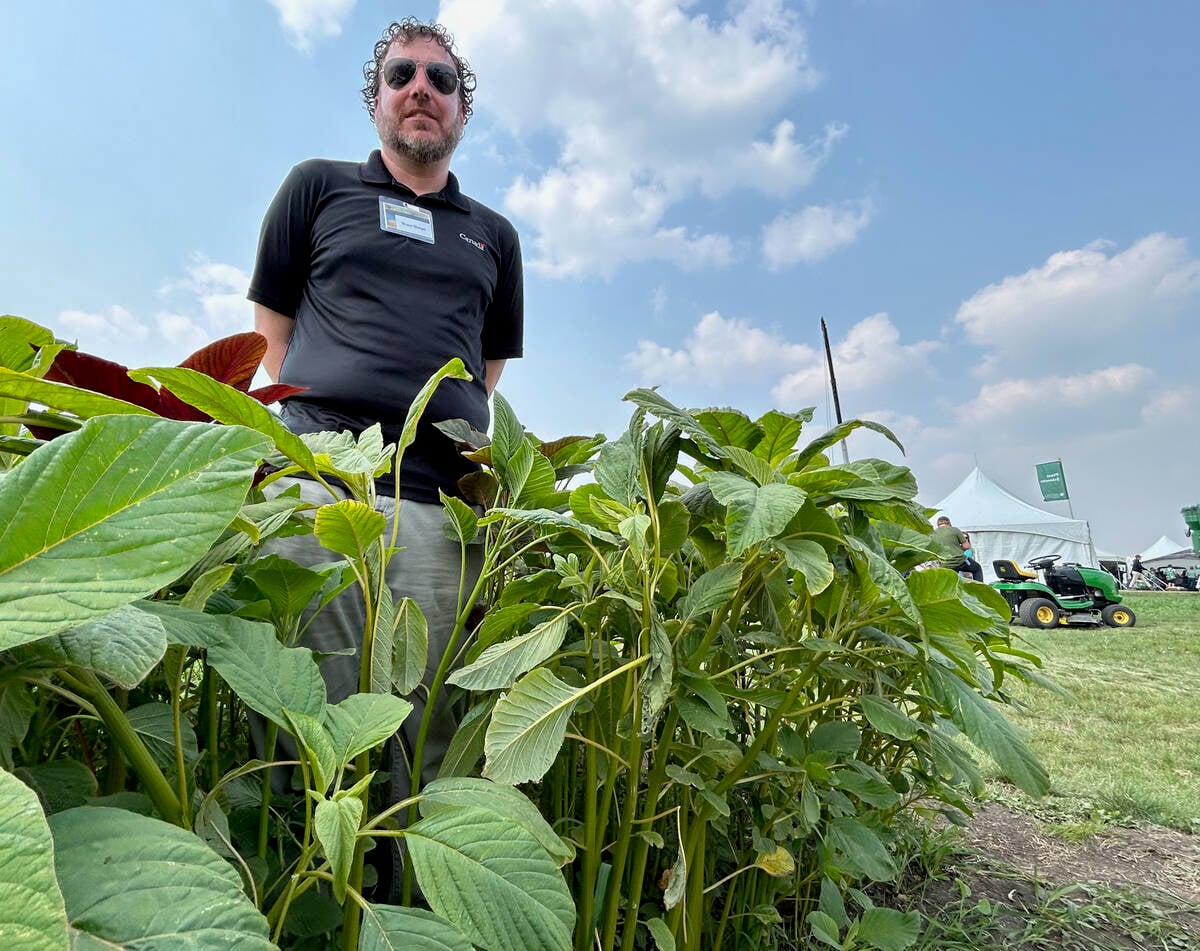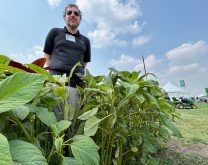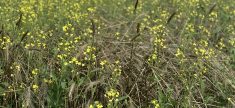An anonymous midge species has been identified in Saskatchewan and central Alberta. The new species is similar to Swede midge (a species already present in Saskatchewan), but to this point does not appear to have caused significant, widespread damage in canola crops.
Researchers are still trying to find out more about the as yet unnamed midge species. “We’ve positively identified that it isn’t Swede midge, and we’ve looked at a lot of other described species. So far, it has not matched up to any of those so we are very certain that it’s yet to be described and is basically a new species,” says research scientist Dr. Boyd Mori of Agriculture and Agri-Food Canada’s Saskatoon Research and Development Centre. Mori first discovered the new midge in soil emergence traps. “We need one more field season to research it and maybe this fall we’ll have a name for it.”
Read Also

Glufosinate-resistant waterhemp appears in U.S. Midwest
News of glufosinate-resistant kochia in the U.S. is concerning as farmers are losing options to control waterhemp, also of the pigweed family.
Judging by what researchers have seen to date, they don’t believe producers should be too concerned about the anonymous midge, or Swede midge, another species that only began showing up in Prairie fields about 10 years ago, for the upcoming season.
Last season’s warm, moist spring, which followed an exceptionally mild winter, provided ideal conditions for an explosion of Swede midge (and presumably the new midge species) across the Prairies. Crops emerged six to seven weeks early, favouring Swede midge, which has caused devastation in Ontario, where it can produce up to four or five generations, depending on conditions, in a single season. “We were definitely anticipating some surprises last season,” says Saskatchewan provincial entomologist Scott Hartley. “A warmer spring than we’d had for a while, and the much earlier emergence of crops provided a longer period of time for something that has multiple generations in a year to attack, and we expected to see more of the symptoms that we see in Ontario.”
Different factors on the Prairies
Thankfully, damage from Swede midge was minimal last year, leading researchers to surmise that the difference in climate on the Prairies — a generally shorter growing season and a cooler spring — could be limiting the number of generations to two or three and preventing both species of midge from becoming more damaging pests in canola.
The first year that Swede midge caused notable damage in Prairie crops was 2012, but it doesn’t appear damage from midge has increased since, so researchers are not sure if Prairie populations are stable. “We just don’t know what they need on the Prairies yet,” says Mori. “As part of a future study, we’re hoping to delve into the life cycle of both this new midge, and Swede midge, to try and determine whether populations are increasing, decreasing or stable and if it is likely to have an impact for producers. Right now, it doesn’t look like it, but if populations were to keep increasing, then every flower on the plant might be affected and if that happens, of course, there’s going to be some yield loss.”
Swede midge, from what researchers understand about its life cycle in Ontario, needs increased soil moisture, warm conditions and a rain event to prompt large emergence. Canola is highly susceptible to Swede midge through almost all growing stages, so with the long length of susceptibility, plus a large number of generations, it could have a dramatic impact on yield, as it often does in Eastern Canada. “The fact that we might only have two or three generations on the Prairies would definitely be helpful,” says Mori. “It would be less opportunity for it to attack canola, and cause less damage.”
A hard pest to control in Canada
There is as yet no economic threshold for Swede midge in canola, and current control strategies are limited.
The female midge lays her eggs on the actively growing tissue and when the larvae feed, they deform and crumple the tissue, and enclose themselves inside the tissue. So far, the only confirmed symptoms from the new midge species are bottle-shaped, galled flowers that form as a result of the larvae feeding inside the flowers. “That makes it hard for a contact insecticide to reach those larvae, so even if farmers spray they are not likely killing them,” says Mori. “It’s very difficult to time sprays to control adults, especially if we have multiple overlapping generations. Unfortunately, right now, controls in canola are lacking. There are two registered insecticides which have been used in Ontario for Swede midge, but as far as determining when to spray, that’s really up to the grower and agronomist to make somewhat of an educated guess to try and do it.”
Damaged flowers do not produce pods and seeds, but because there are a lot of other reasons why canola may not produce pods, including heat blasting or lygus bugs, it would be necessary to find the midge in the flowers to confirm they are the cause of reduced pod production.
Better management options for now, would appear to be planting as early as possible and longer rotations. “The faster farmers can get the canola crop to the early pod formation stage the better, because that’s really when it’s no longer susceptible to Swede midge,” says Mori. “Rotation is definitely key, as Swede midge can overwinter as pupae in the soil for longer than one year. If farmers have a short rotation, they may think it’s okay to grow canola one year, followed by wheat, and then go back to canola, but there could still be pupae from two years prior in that field that are emerging. Unfortunately, we do see a lot more short rotations on the Prairies, but if we could increase these rotations again, that would definitely have an impact on Swede midge populations and many other pests also.”
There’s also some hope for biological control. Researchers have found two species of parasitoid wasps in Saskatchewan that could provide effective, natural control for midge.
‘Right now we’re not sure if these wasps are parasitizing both the Swede midge and this anonymous midge, so we want to do more research to see which species they are attacking,” says Mori. “Last summer was the first year that they found parasitoids of midge in Ontario. They found one species and it’s not the same as either of the two species found in Saskatchewan. Swede midge has been in Ontario for over 20 years, so it’s quite interesting that it’s taken over 20 years for there to be a parasitoid there, but it’s taken less than 10 years for there to be parasitoids in Saskatchewan.”
Species could be native
The wide distribution of the new anonymous midge species and the discovery that there are parasitic insects for Swede midge already present on the Prairies makes researchers wonder if the new midge might be a native species that has developed new tastes. “It’s pure speculation at this point, but to this point we have found the anonymous midge on quite a wide scale. We found it all across northern Saskatchewan and throughout east and central Alberta. Given that it has this large distribution, I’m inclined to think it might be a native species that has switched, and taken the opportunity now that we have so much canola grown, to develop on canola,” says Mori. “It’s slightly supported by the fact that there are two parasitoids that might be parasitizing it. If it’s native you’d think that there would be some native parasitoids associated with it, so that could be supportive of the fact that it’s native, but we’re not sure. This summer we’re going to look at some of the brassica weed species to see if it is also developing on them in the field, and determine if they could be an alternative host, or maybe the natural host, for this midge.”
Mori emphasizes that farmers should remain vigilant, but not overly concerned about Swede or the anonymous midge for the present. “Luckily Swede midge was not an issue last summer, we didn’t find any, but perhaps the places we put our pheromone traps may not have had the populations there. They could have been a few miles down the road,” says Mori. “We advise farmers to be vigilant, and if they see large scale damage that looks like an insect pest, and that might be one of these midges, get in touch with us and we’ll help figure this out. Meanwhile, we’ll continue to research it and try and figure out if it will become an economic pest in the future.”
















